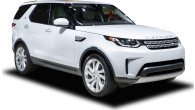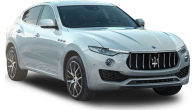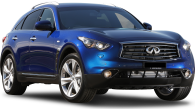The luxury SUV segment is currently bursting at its double-stitched seams with new entrants from the likes of Alfa Romeo, Bentley, and Maserati, and the influx isn't stopping there.
Most of those brands offer a model that takes the notion of high-end luxury and turns it up to 11, with a big engine, sporty suspension and revised dynamics.
Range Rover is no different. Its Range Rover Sport is its most agile offering, and the heavily tweaked SVR adds more than just a dash of power-crazed lunatic into the mix. We tested the new SVR (at speed!) in and around Jaguar Land Rover’s Fen End proving grounds in the UK… and colour us impressed. This thing is a freakin’ fun fair.
Land Rover Range Rover Sport 2018: V8 SC SVR
| Engine Type | Supercharged V8, 5.0L |
|---|---|
| Fuel Type | Premium Unleaded Petrol |
| Fuel Efficiency | 12.8L/100km (combined) |
| Seating | 5 |
| Price From | $125,400 - $144,100 |
Is there anything interesting about its design?
8 / 10
The Rangie hasn’t strayed too far from its 1980s origins in terms of its overall shape; it hasn’t stayed as faithful as a Porsche 911, but it’s not far off.
.jpg)
This latest Rangie Sport is almost four years old now, but it retains a sense of urban style that springs from its solid, inspiring, original design.
The 2018 model gets a new bar, grille and matrix LED headlights up front, and a revised rear bar cover out back that wraps around the fake exhaust tips. Being an SVR, 21-inch rims are standard, and 22s are popular.
.jpg)
Inside, it’s understated, classic simplicity that’s been enhanced for the new model, thanks to the dual multimedia screens and digital dash. There are very, very few dials on the centre console apart from the beautifully executed climate control system, and all touch points are spot on.
Does it represent good value for the price? What features does it come with?
7 / 10
The Sport SVR is the gunship of the fleet, and it’ll be priced at $238,200 when it arrives later this year. Impressively, the price of the SVR hasn’t really risen, despite extra inclusions like magnesium framed sports seats and more power.
.jpg)
Apart from the usual leather-lined interior and large panoramic sunroof that you would expect from a premium-priced SUV, it sports automatic lights and wipers, four-zone climate control, brushed-aluminium finish, smart key with push button start/stop, heated front and rear seats and a powered tailgate.
One thing to watch for; Range Rover’s options lists are longer than a re-run of I Married A Stranger, so it’s easy to send the dollar figure of an SVR into the stratosphere.
.jpg)
How practical is the space inside?
6 / 10
One of the first things that strikes you about the Range Rover Sport is that it feels huge inside the cabin, despite the fact that it’s the smaller of the Range Rover siblings.
Despite its size, though, it’s perhaps not as contemporary as many of its competitors. For example, while there are two large cup holders in the front console, the door pockets in the front don't accept bottles easily.
And despite the fact there are plenty of them, the USB ports are mostly hidden away up front. Thankfully, rear-seat passengers now have their own USB and 12V points, and they also have access to climate controls.
Even though we should all be hiding our phones away and not using them, there is no logical place to stash your mobile device, either, other than in the glove box or centre-console bin. Maybe Rangie is trying to tell us something…
.jpg)
The second row of seats is wide, deep, and comfortable, but while the middle seat is usable, it lacks the bolstering and cushioning of the outside pair. There are ISOFIX mounts for the outside rear seats, too.
In terms of volume, there’s 784 litres available with the second row up, and 1761 with the second row lowered.
If you want to tow a van with your 600bhp SUV, feel free; the SVR can tow 3500kg of braked trailer.
What are the key stats for the engine and transmission?
8 / 10
The SVR uses Jaguar Land Rover’s much loved 5.0-litre supercharged V8, and in this case it makes 423kW and a stonking 700Nm of torque.
.jpg)
The gains have come mainly from a re-ported supercharger, which has also been geared to spin faster and make more go-fast boost. The revised exhaust system is also lighter (and so much noisier), while the engine computer’s been tweaked as well.
The driveline is all-wheel drive and features strengthened front half-shafts to deal with all that oomph. It still incorporates Range Rover’s excellent All Terrain Control system, despite its sports-car bent, and it allows the driver to quickly switch between off-road modes.
It’s actually quite astonishing how off-road capable the Sport SVR is, too, as we found after navigating a short, muddy course that was slipperier than an Australian's ball handling. Too soon?
How much fuel does it consume?
7 / 10
Range Rover rates the SVR as consuming 12.8 litres per 100km on the combined fuel economy cycle – which is actually 1.1 litres less than the previous generation, despite having more power.
However, the reality is a lot different if you drive like… well, us. A brief sortie saw fuel numbers spiral towards 20 litres per 100km on the dash, and you’ll have to be super disciplined to post low figures.
There’s a 104-litre tank in the Sport SVR, which still only equates to a theoretical fuel range of 820km.
What's it like to drive?
9 / 10
Put simply, the SVR is an unabashed lunatic draped in a conservative suit. Able to blast to 100km/h in just 4.5 seconds, the prodigious torque from the supercharged V8 turns this 2250kg five-seat wagon into a ground-bound intra-city missile, complete with an outrageously amusing exhaust performance that would embarrass a thrash-metal concert.
Ludicrously loud crackles and grumbles on throttle overrun are just part of the fun, with the SVR’s thunderous baritone supercharger howl the equivalent of a low-level Hawker Hurricane fly-by at full song.
.jpg)
And its pace is simply incredible. The SVR is seriously fast in any gear, with that prodigious torque available right through the rev range. Occasionally I wished the throttle response could have been a bit more linear; there were a couple of times where a little prod equalled a big input and a noticeable forward surge, which would upset the chassis a bit.
The SVR has been massaged dynamically, as well, with the previously brittle-edged ride of the Dynamic mode now replaced by a vastly more sophisticated feel. What’s more, the driver can personalise the drive mode to allow the dampers to be turned down, giving the big SUV genuinely amazing abilities on bumpy back roads.
Steering feel verges on the light side, and sitting a bit lower in the car would make for a better connection – although that would then make forward vision tough over the bluff clamshell bonnet.
Warranty & Safety Rating
What safety equipment is fitted? What safety rating?
8 / 10
The Range Rover Sport SVR has a maximum five-star score from ANCAP, with safety features including curtain airbags, seat-side and thorax bags, while AEB is standard.
Radar cruise control and advanced emergency braking are a $3700 option.
What does it cost to own? What warranty is offered?
7 / 10
Range Rover recommends servicing the Sport every 12 months or 26,000km, which is pretty impressive mileage. It offers a three-year, 100,00km warranty as standard, with free roadside assistance for the duration of the warranty.
No fixed-price service plan exists for the Sport.
Verdict
The breadth of ability that the SVR offers is pretty remarkable, and it could happily lay waste to more than one modern sports car, in the right hands.
Come the weekend, it can tow a van or boat with ease, and comfortably seat a family of five, then back up during the week as an exec express par excellence.
Some may argue that it’s a big departure from the Range Rover ethos of practical luxury, but I’d argue that the SVR manages to retain that utility while blending in a large dose of entertainment. And having fun isn’t illegal… yet.
Would you like your Range Rover this crazy, or is it just too much?
Pricing Guides



.jpg)


































_0.jpg)
.jpg)


.jpg)

